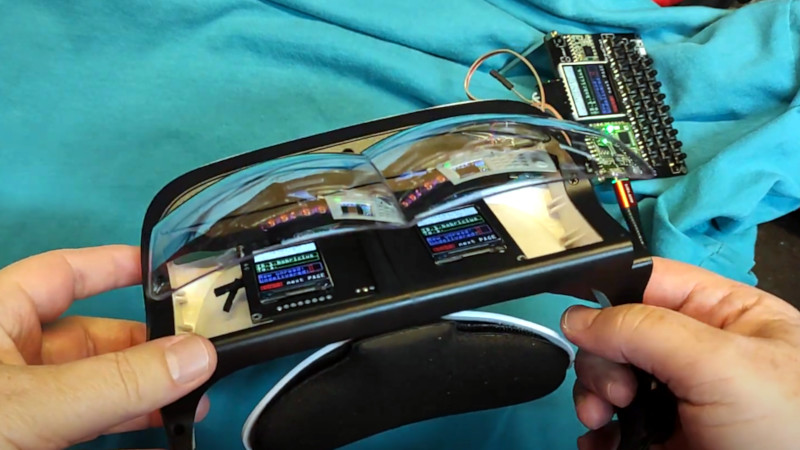Community, Leadership, Experimentation, Diversity, & Education
Pittsburgh Arts, Regional Theatre, New Work, Producing, Copyright, Labor Unions,
New Products, Coping Skills, J-O-Bs...
Theatre industry news, University & School of Drama Announcements, plus occasional course support for
Carnegie Mellon School of Drama Faculty, Staff, Students, and Alumni.
CMU School of Drama
Friday, September 03, 2021
A Microcontroller Friendly AR Headset On The Cheap
Hackaday: Generating the real-time images required for augmented reality (AR) goggles usually requires a fair amount of processing power, to the point that DIY efforts based around the Raspberry Pi often have trouble keeping up. But what if your AR aspirations don’t require fancy high-resolution graphics? If text and the occasional icon is enough to get the job done, then these lo-fi AR goggles from [bobricius] might be the ideal solution.
Subscribe to:
Post Comments (Atom)

4 comments:
I am really excited for augmented reality to make it to a usable, commercial, available state instead of a niche thing. It seems like there's just so many cool uses, and the technology is good enough at this point that I think if someone came up with a really good platform, a headset and sensor suite with built-in software tools for things like computer vision, object recognition, and speech recognition, it would explode like the App Store after the first iPhone. From facial recognition with AR name tags to automatic captioning for differently abled audience members to really, really cool interactive media designs to tools that lay out measurements and angles based on a drawing so that carpenters don't need a measuring tape, they just line things up with their visual overlay, there's just so much potential in theatre, and that's not even getting into all the things people could do with it in their daily lives or other industries.
In my opinion, any idea or development along the lines of virtual and/or augmented reality can often seem like a far fetched and somewhat out-of-reach futuristic dream. But with the rapid progression of modern-day technology, AR has become far more prominent, realistic, and accessible. The article highlights the latter in particular; Tom Nardi’s detailed explanation of the creation and science behind a newer version of microcontrollers in AR goggles is very interesting, but the device’s accessibility and affordability is arguably a much more valuable point to consider. A lot of advanced technology in the world today is still unethically made and not readily available, a capitalistic burden to how society as a whole can progress technologically. The custom PCB spotlighted in the article is a fine example of making seemingly high-end, innovative tech both more simplistic and attainable, something that should be considered and integrated more into the future.
Cost and computing power remain the largest chains around the legs of VR. Far from the future of the general populace wandering around daily life with headsets in front of their eyes that seemed imminent, it still remains in the realm of hobbyists, tech enthusiasts and NFT artists. However, this article suggests a different path: rather than go for high-tech full immersion headsets, use cheap lenses along with microcontrollers to create simple glasses that can display basic messages. Without the weight or obstruction of regular view, and the relatively small scope of the project, these AR glasses promise use in a variety of situations. One could easily imagine a smaller production purchasing or making enough of these glasses to hand out to an entire audience for an installation where different instructions flashed across the lenses at different times, or gave visual stimulus based on where people were standing in a room. Aside from theatre, I’m sure we’ll also see plenty of businesspeople checking their email without the neck strain of looking down at their phone from now on. The possibilities inherent in these glasses are numerous.
Cost and computing power remain the largest chains around the legs of VR. Far from the future of the general populace wandering around daily life with headsets in front of their eyes that seemed imminent, it still remains in the realm of hobbyists, tech enthusiasts and NFT artists. However, this article suggests a different path: rather than go for high-tech full immersion headsets, use cheap lenses along with microcontrollers to create simple glasses that can display basic messages. Without the weight or obstruction of regular view, and the relatively small scope of the project, these AR glasses promise use in a variety of situations. One could easily imagine a smaller production purchasing or making enough of these glasses to hand out to an entire audience for an installation where different instructions flashed across the lenses at different times, or gave visual stimulus based on where people were standing in a room. Aside from theatre, I’m sure we’ll also see plenty of businesspeople checking their email without the neck strain of looking down at their phone from now on. The possibilities inherent in these glasses are numerous.
P.S. First time I posted this it didn't include my name, so I'm signing it.
-Zach Everett-Lane
Post a Comment